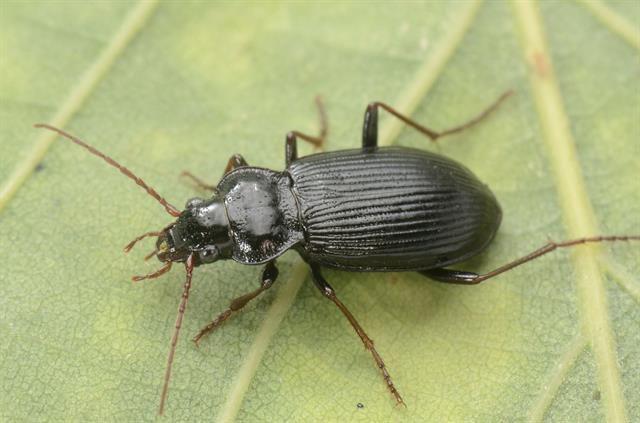Invasive insect species on the move, with big consequences
The European Gazelle Beetle is an invasive species that has recently arrived in Oregon. (Photo courtesy of the Encyclopedia of Life.)
Jim Labonte works with bugs.
A single scoop full of Oregon dirt can contain a dozen of the creatures, black and no larger than a fingernail. Labonte, an entomologist with the Oregon Department of Agriculture, is studying the creatures, which only were first discovered in North America just a few years ago.
The beetles are an invasive species from Europe called Nebria brevicollis, the European gazelle beetle. Labonte said they’ve become so abundant that scientists are concerned they’re becoming so abundant they will compete with and exclude other, native species.
Labonte’s role at the agriculture department is to monitor for exotic species — exotic meaning coming from somewhere else. And this particular beetle is just one of many species he’s tracking.
In the past few years, he’s found one new foreign species every month, and those are just the ones he’s detected.
“This is called a pitfall trap. It’s set in the ground, and it’s used for catching insects that will crawl over the ground,” he said.
Labonte’s trap was setup in a vineyard in Hillsboro, outside Portland. A mix of native and exotic bugs speckle the green liquid at the bottom of the trap. The same goes for the other traps scattered about the vineyard; some local bugs, some foreign ones. Labonte doesn’t welcome the ones from some place else.
“It’s a type of ecological pollution, if you will. They don’t belong there,” he said.
The real problems start when an exotic species becomes invasive, causing severe ecological and economic damage
Take the gypsy moth, for example.
“Gypsy moth love oak trees. So where you have heavy infestations of gypsy moth, oak trees tend to diminish after a while,” he said.
That leads to maple trees growing, which is fine, except for the Asian longhorn beetle.
“(It) loves maple trees. So if that gets well-established, you can pretty much kiss off maple trees,” Labonte said. “So when you lose one species, you don’t normally lose just one species. You lose the species that are dependent on it or associated with it.”
Labonte’s wife, Diana Kimberling, agrees. She’s also an entomologist for the Oregon Department of Agriculture.
“Last year we were dealing with eradicating gypsy moth here in Oregon,” she said. “If it did become established, a lot of the native moths that are dependent on oaks could be outcompeted. So when those native species decline and you just have a single dominant exotic, it really does have this whole cascade of effects.”
The real culprit here is global trade. Insects can burrow into packing crates, or stow away on cargo ships, and end up on a different coast, like in Oregon.
Labonte says the key is to detect the invaders early, before they can get established and wreak havoc on the ecosystem.
But that’s easier said than done. On one eradication mission in Chicago, Labonte was targeting Asian longhorn beetles, which burrow into live maple trees.
The only recourse is to chop the tree down and burn or chip the tree up so small that no larvae could survive. Labonte found an infected tree, a maple, in a woman’s backyard.
“One of the most distressing things that I’ve had to do in my career was to tell the homeowner that this wonderful, beautiful tree was going to have to be destroyed,” he said. “And she was clearly heartbroken, and understandably so — this tree had been part of her life. She had grown up in this house.”
